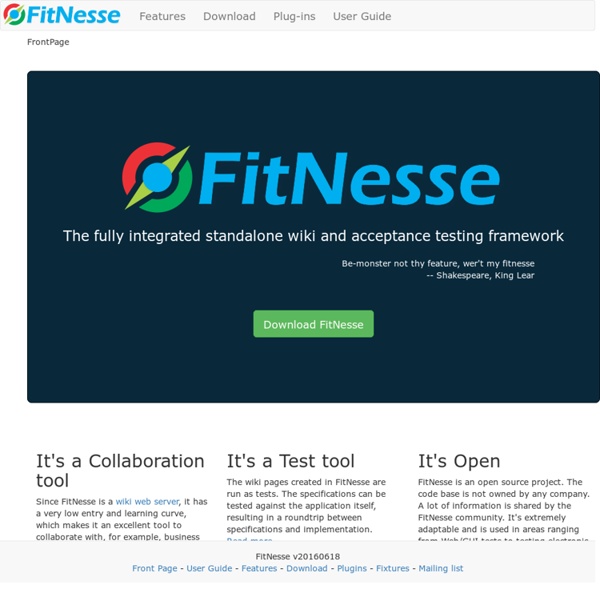



specs2 @ GitHub Specify your software using both text and Scala code class HelloWorldSpec extends Specification { def is = s2""" This is a specification for the 'Hello world' string The 'Hello world' string should contain 11 characters $e1 start with 'Hello' $e2 end with 'world' $e3 """ def e1 = "Hello world" must haveSize(11) def e2 = "Hello world" must startWith("Hello") def e3 = "Hello world" must endWith("world") } Use different styles of specifications /** This is the "Unit" style for specifications */class HelloWorldSpec extends Specification { "This is a specification for the 'Hello world' string".txt "The 'Hello world' string should" >> { "contain 11 characters" >> { "Hello world" must haveSize(11) } "start with 'Hello'" >> { "Hello world" must startWith("Hello") } "end with 'world'" >> { "Hello world" must endWith("world") } }} Document your APIs with compiler-checked examples Manage contexts for integration testing
You Test It ! Watir.com | Web Application Testing in Ruby Unit testing In computer programming, unit testing is a method by which individual units of source code, sets of one or more computer program modules together with associated control data, usage procedures, and operating procedures are tested to determine if they are fit for use.[1] Intuitively, one can view a unit as the smallest testable part of an application. In procedural programming, a unit could be an entire module, but it is more commonly an individual function or procedure. In object-oriented programming, a unit is often an entire interface, such as a class, but could be an individual method.[2] Unit tests are short code fragments[3] created by programmers or occasionally by white box testers during the development process. Ideally, each test case is independent from the others. Benefits[edit] The goal of unit testing is to isolate each part of the program and show that the individual parts are correct.[1] A unit test provides a strict, written contract that the piece of code must satisfy.
Selenium - Web Browser Automation Test-driven development Software design using test cases Test-driven development (TDD) is a software development process relying on software requirements being converted to test cases before software is fully developed, and tracking all software development by repeatedly testing the software against all test cases. This is as opposed to software being developed first and test cases created later. Software engineer Kent Beck, who is credited with having developed or "rediscovered"[1] the technique, stated in 2003 that TDD encourages simple designs and inspires confidence.[2] Test-driven development is related to the test-first programming concepts of extreme programming, begun in 1999,[3] but more recently has created more general interest in its own right.[4] Programmers also apply the concept to improving and debugging legacy code developed with older techniques.[5] Test-driven development cycle[edit] The following sequence is based on the book Test-Driven Development by Example:[2] 1. 2. 3. 4. 5. Repeat
Selenium WebDriver The biggest change in Selenium recently has been the inclusion of the WebDriver API. Driving a browser natively as a user would either locally or on a remote machine using the Selenium Server it marks a leap forward in terms of browser automation. Selenium WebDriver fits in the same role as RC did, and has incorporated the original 1.x bindings. It refers to both the language bindings and the implementations of the individual browser controlling code. This is commonly referred to as just "WebDriver" or sometimes as Selenium 2. WebDriver is the name of the key interface against which tests should be written in Java, the implementing classes one should use are listed as below: AndroidDriver, ChromeDriver, EventFiringWebDriver, FirefoxDriver, HtmlUnitDriver, InternetExplorerDriver, PhantomJSDriver, RemoteWebDriver, SafariDriver For More information on Selenium WebDriver, please see the documentation and Remote Control to WebDriver Migration Notes.
Cuke4Ninja: The Secret Ninja Cucumber Scrolls | Cucumber | Gherkin | Agile Acceptance Testing | Behaviour Driven Development Test Plan Sample Table of Contents 1. Introduction Description of this Document Related Documents Schedule and Milestones 2. 3. New Features Testing Regression Testing 4. 5. 6. 7. 1. Description of this Document This document is a Test Plan for the -Project name-, produced by Quality Assurance. The focus of the -Project name- is to support those new features that will allow easier development, deployment and maintenance of solutions built upon the -Project name-. [List of the features] This release of the -Project name- will also include legacy bug fixing, and redesigning or including missing functionality from previous release The following implementations were made: [List and description of implementations made] Related Documents [List of related documents such as: Functional Specifications, Design Specifications] Schedule and Milestones [Schedule information QA testing estimates] 2. Hardware [List of hardware requirements] Software [List of software requirements: primary and secondary OS] Staffing 3. 4. 5. 6. Risks
Behavior Driven Development In software engineering, behavior-driven development (abbreviated BDD) is a software development process based on test-driven development (TDD).[1][2] Behavior-driven development combines the general techniques and principles of TDD with ideas from domain-driven design and object-oriented analysis and design to provide software developers and business analysts with shared tools and a shared process to collaborate on software development,[1][3] with the aim of delivering "software that matters".[4] Although BDD is principally an idea about how software development should be managed by both business interests and technical insight, the practice of BDD does assume the use of specialized software tools to support the development process.[2] Although these tools are often developed specifically for use in BDD projects, they can be seen as specialized forms of the tooling that supports test-driven development. History[edit] Principles of BDD[edit] Behavioral specifications[edit] See Also[edit]
Welcome to JUnit.org! | JUnit.org HttpUnit Home
Excelent tool recomended from Master Hayden Schultz by kobda Dec 13